Nursing Assignment: Exploring Discrimination in Healthcare, Analysis
VerifiedAdded on 2020/05/28
|8
|1749
|79
Essay
AI Summary
This nursing assignment explores the pervasive issue of discrimination within healthcare settings, examining its various forms and impacts on patients. The paper delves into how discrimination manifests, including instances of refusal of service, unequal treatment, and harassment, all of which contravene fundamental human rights and the Equality Act 2010. It highlights protected characteristics like age, gender, and sexual orientation, and how discrimination hinders access to healthcare and undermines universal health coverage goals. The assignment analyzes specific examples of discriminatory practices, such as terminating services based on protected characteristics or providing substandard care, and discusses the negative consequences on social determinants of health. It underscores the importance of legal frameworks, such as the Equality Act 2010, and calls for combined efforts from healthcare providers, patients, and administrative organizations to combat discrimination and promote fairness in healthcare delivery. The assignment concludes by emphasizing the need for a broader societal commitment to eliminate discrimination in all sectors.
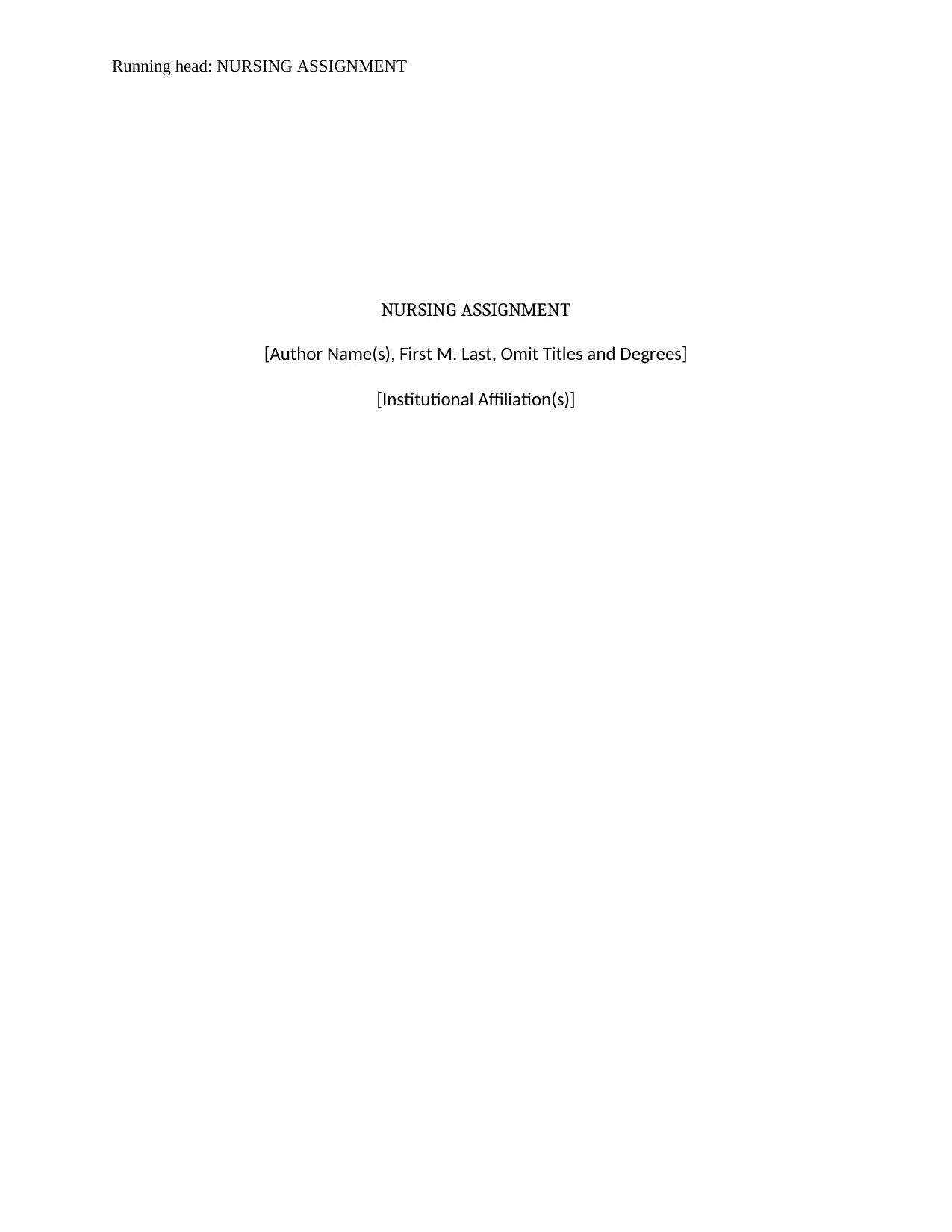
Running head: NURSING ASSIGNMENT
NURSING ASSIGNMENT
[Author Name(s), First M. Last, Omit Titles and Degrees]
[Institutional Affiliation(s)]
NURSING ASSIGNMENT
[Author Name(s), First M. Last, Omit Titles and Degrees]
[Institutional Affiliation(s)]
Paraphrase This Document
Need a fresh take? Get an instant paraphrase of this document with our AI Paraphraser
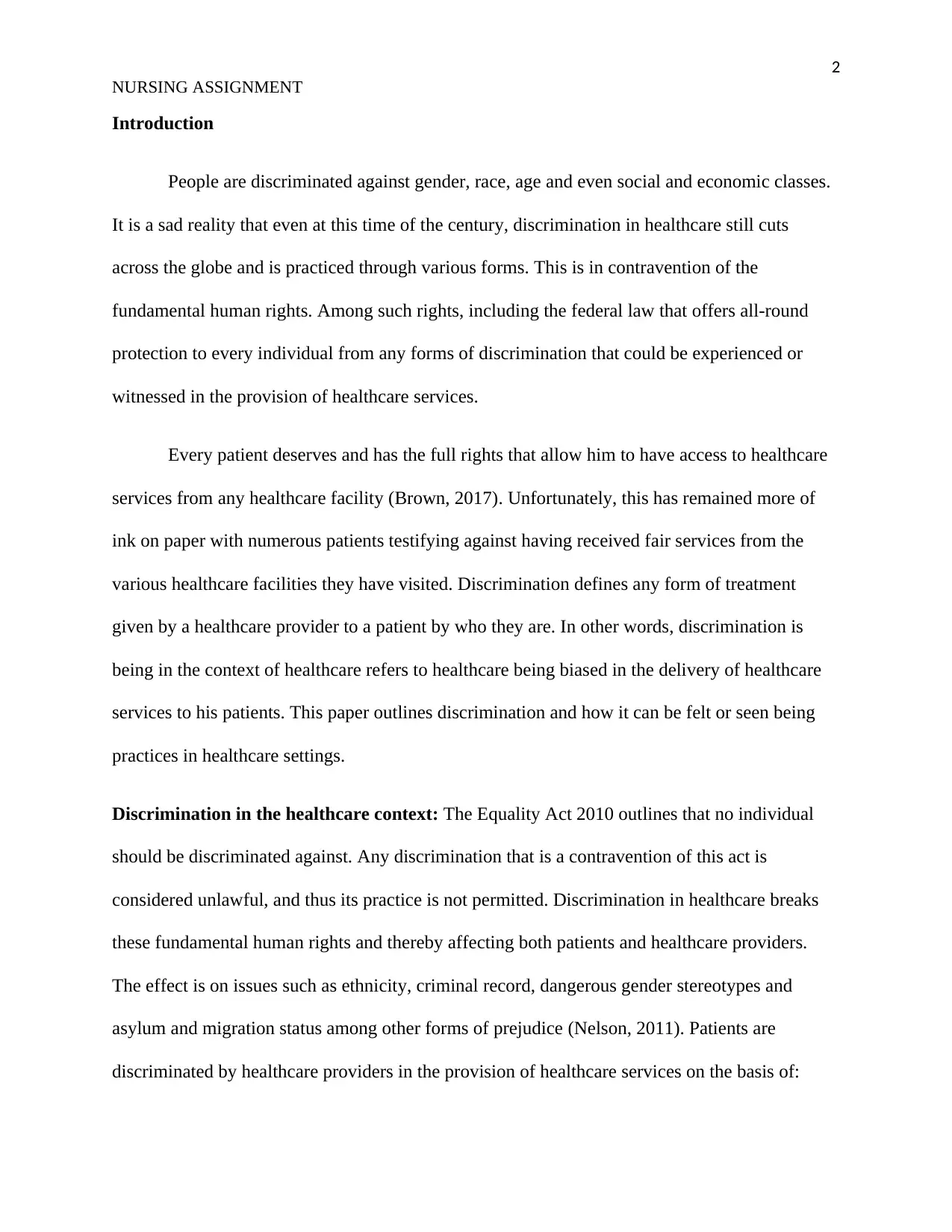
2
NURSING ASSIGNMENT
Introduction
People are discriminated against gender, race, age and even social and economic classes.
It is a sad reality that even at this time of the century, discrimination in healthcare still cuts
across the globe and is practiced through various forms. This is in contravention of the
fundamental human rights. Among such rights, including the federal law that offers all-round
protection to every individual from any forms of discrimination that could be experienced or
witnessed in the provision of healthcare services.
Every patient deserves and has the full rights that allow him to have access to healthcare
services from any healthcare facility (Brown, 2017). Unfortunately, this has remained more of
ink on paper with numerous patients testifying against having received fair services from the
various healthcare facilities they have visited. Discrimination defines any form of treatment
given by a healthcare provider to a patient by who they are. In other words, discrimination is
being in the context of healthcare refers to healthcare being biased in the delivery of healthcare
services to his patients. This paper outlines discrimination and how it can be felt or seen being
practices in healthcare settings.
Discrimination in the healthcare context: The Equality Act 2010 outlines that no individual
should be discriminated against. Any discrimination that is a contravention of this act is
considered unlawful, and thus its practice is not permitted. Discrimination in healthcare breaks
these fundamental human rights and thereby affecting both patients and healthcare providers.
The effect is on issues such as ethnicity, criminal record, dangerous gender stereotypes and
asylum and migration status among other forms of prejudice (Nelson, 2011). Patients are
discriminated by healthcare providers in the provision of healthcare services on the basis of:
NURSING ASSIGNMENT
Introduction
People are discriminated against gender, race, age and even social and economic classes.
It is a sad reality that even at this time of the century, discrimination in healthcare still cuts
across the globe and is practiced through various forms. This is in contravention of the
fundamental human rights. Among such rights, including the federal law that offers all-round
protection to every individual from any forms of discrimination that could be experienced or
witnessed in the provision of healthcare services.
Every patient deserves and has the full rights that allow him to have access to healthcare
services from any healthcare facility (Brown, 2017). Unfortunately, this has remained more of
ink on paper with numerous patients testifying against having received fair services from the
various healthcare facilities they have visited. Discrimination defines any form of treatment
given by a healthcare provider to a patient by who they are. In other words, discrimination is
being in the context of healthcare refers to healthcare being biased in the delivery of healthcare
services to his patients. This paper outlines discrimination and how it can be felt or seen being
practices in healthcare settings.
Discrimination in the healthcare context: The Equality Act 2010 outlines that no individual
should be discriminated against. Any discrimination that is a contravention of this act is
considered unlawful, and thus its practice is not permitted. Discrimination in healthcare breaks
these fundamental human rights and thereby affecting both patients and healthcare providers.
The effect is on issues such as ethnicity, criminal record, dangerous gender stereotypes and
asylum and migration status among other forms of prejudice (Nelson, 2011). Patients are
discriminated by healthcare providers in the provision of healthcare services on the basis of:
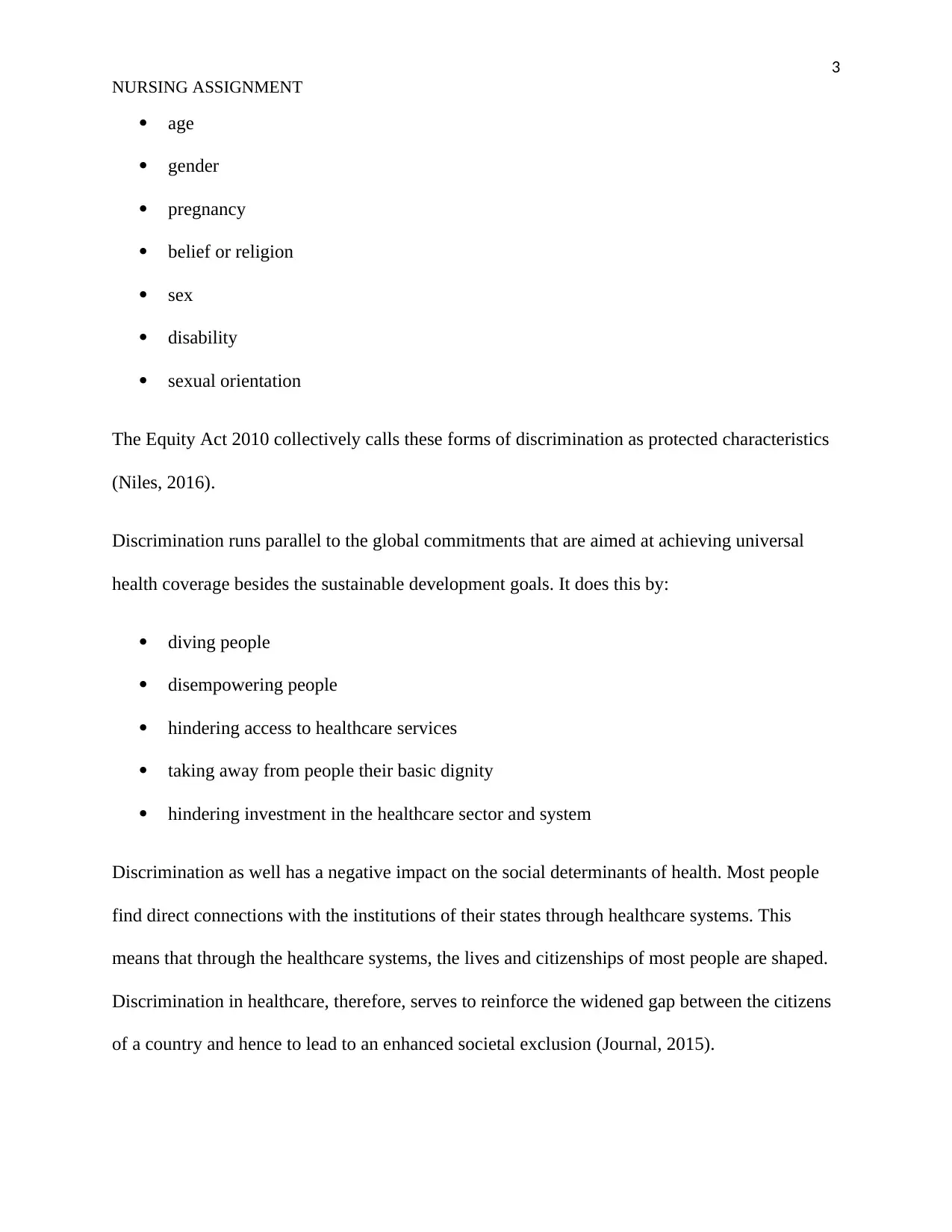
3
NURSING ASSIGNMENT
age
gender
pregnancy
belief or religion
sex
disability
sexual orientation
The Equity Act 2010 collectively calls these forms of discrimination as protected characteristics
(Niles, 2016).
Discrimination runs parallel to the global commitments that are aimed at achieving universal
health coverage besides the sustainable development goals. It does this by:
diving people
disempowering people
hindering access to healthcare services
taking away from people their basic dignity
hindering investment in the healthcare sector and system
Discrimination as well has a negative impact on the social determinants of health. Most people
find direct connections with the institutions of their states through healthcare systems. This
means that through the healthcare systems, the lives and citizenships of most people are shaped.
Discrimination in healthcare, therefore, serves to reinforce the widened gap between the citizens
of a country and hence to lead to an enhanced societal exclusion (Journal, 2015).
NURSING ASSIGNMENT
age
gender
pregnancy
belief or religion
sex
disability
sexual orientation
The Equity Act 2010 collectively calls these forms of discrimination as protected characteristics
(Niles, 2016).
Discrimination runs parallel to the global commitments that are aimed at achieving universal
health coverage besides the sustainable development goals. It does this by:
diving people
disempowering people
hindering access to healthcare services
taking away from people their basic dignity
hindering investment in the healthcare sector and system
Discrimination as well has a negative impact on the social determinants of health. Most people
find direct connections with the institutions of their states through healthcare systems. This
means that through the healthcare systems, the lives and citizenships of most people are shaped.
Discrimination in healthcare, therefore, serves to reinforce the widened gap between the citizens
of a country and hence to lead to an enhanced societal exclusion (Journal, 2015).
⊘ This is a preview!⊘
Do you want full access?
Subscribe today to unlock all pages.

Trusted by 1+ million students worldwide
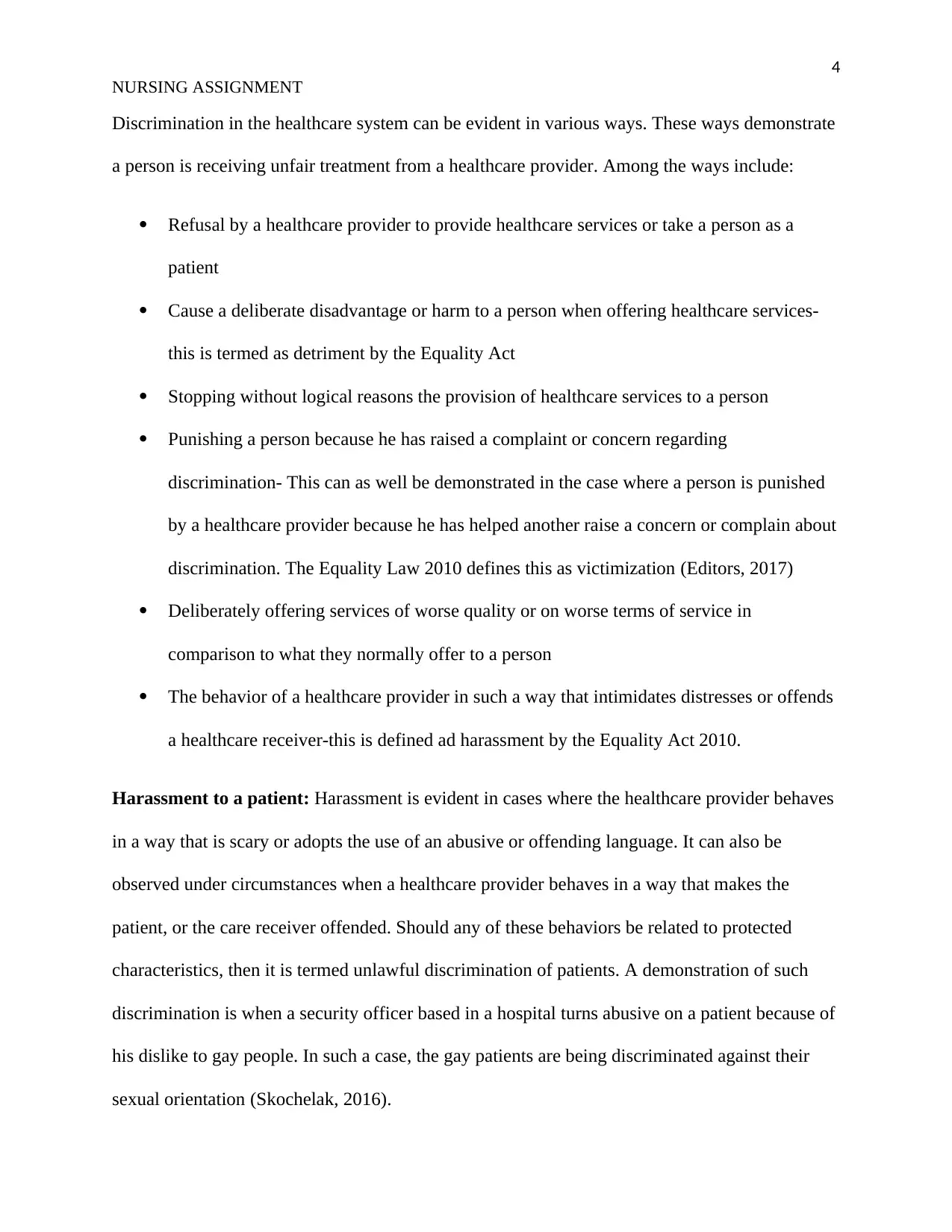
4
NURSING ASSIGNMENT
Discrimination in the healthcare system can be evident in various ways. These ways demonstrate
a person is receiving unfair treatment from a healthcare provider. Among the ways include:
Refusal by a healthcare provider to provide healthcare services or take a person as a
patient
Cause a deliberate disadvantage or harm to a person when offering healthcare services-
this is termed as detriment by the Equality Act
Stopping without logical reasons the provision of healthcare services to a person
Punishing a person because he has raised a complaint or concern regarding
discrimination- This can as well be demonstrated in the case where a person is punished
by a healthcare provider because he has helped another raise a concern or complain about
discrimination. The Equality Law 2010 defines this as victimization (Editors, 2017)
Deliberately offering services of worse quality or on worse terms of service in
comparison to what they normally offer to a person
The behavior of a healthcare provider in such a way that intimidates distresses or offends
a healthcare receiver-this is defined ad harassment by the Equality Act 2010.
Harassment to a patient: Harassment is evident in cases where the healthcare provider behaves
in a way that is scary or adopts the use of an abusive or offending language. It can also be
observed under circumstances when a healthcare provider behaves in a way that makes the
patient, or the care receiver offended. Should any of these behaviors be related to protected
characteristics, then it is termed unlawful discrimination of patients. A demonstration of such
discrimination is when a security officer based in a hospital turns abusive on a patient because of
his dislike to gay people. In such a case, the gay patients are being discriminated against their
sexual orientation (Skochelak, 2016).
NURSING ASSIGNMENT
Discrimination in the healthcare system can be evident in various ways. These ways demonstrate
a person is receiving unfair treatment from a healthcare provider. Among the ways include:
Refusal by a healthcare provider to provide healthcare services or take a person as a
patient
Cause a deliberate disadvantage or harm to a person when offering healthcare services-
this is termed as detriment by the Equality Act
Stopping without logical reasons the provision of healthcare services to a person
Punishing a person because he has raised a complaint or concern regarding
discrimination- This can as well be demonstrated in the case where a person is punished
by a healthcare provider because he has helped another raise a concern or complain about
discrimination. The Equality Law 2010 defines this as victimization (Editors, 2017)
Deliberately offering services of worse quality or on worse terms of service in
comparison to what they normally offer to a person
The behavior of a healthcare provider in such a way that intimidates distresses or offends
a healthcare receiver-this is defined ad harassment by the Equality Act 2010.
Harassment to a patient: Harassment is evident in cases where the healthcare provider behaves
in a way that is scary or adopts the use of an abusive or offending language. It can also be
observed under circumstances when a healthcare provider behaves in a way that makes the
patient, or the care receiver offended. Should any of these behaviors be related to protected
characteristics, then it is termed unlawful discrimination of patients. A demonstration of such
discrimination is when a security officer based in a hospital turns abusive on a patient because of
his dislike to gay people. In such a case, the gay patients are being discriminated against their
sexual orientation (Skochelak, 2016).
Paraphrase This Document
Need a fresh take? Get an instant paraphrase of this document with our AI Paraphraser
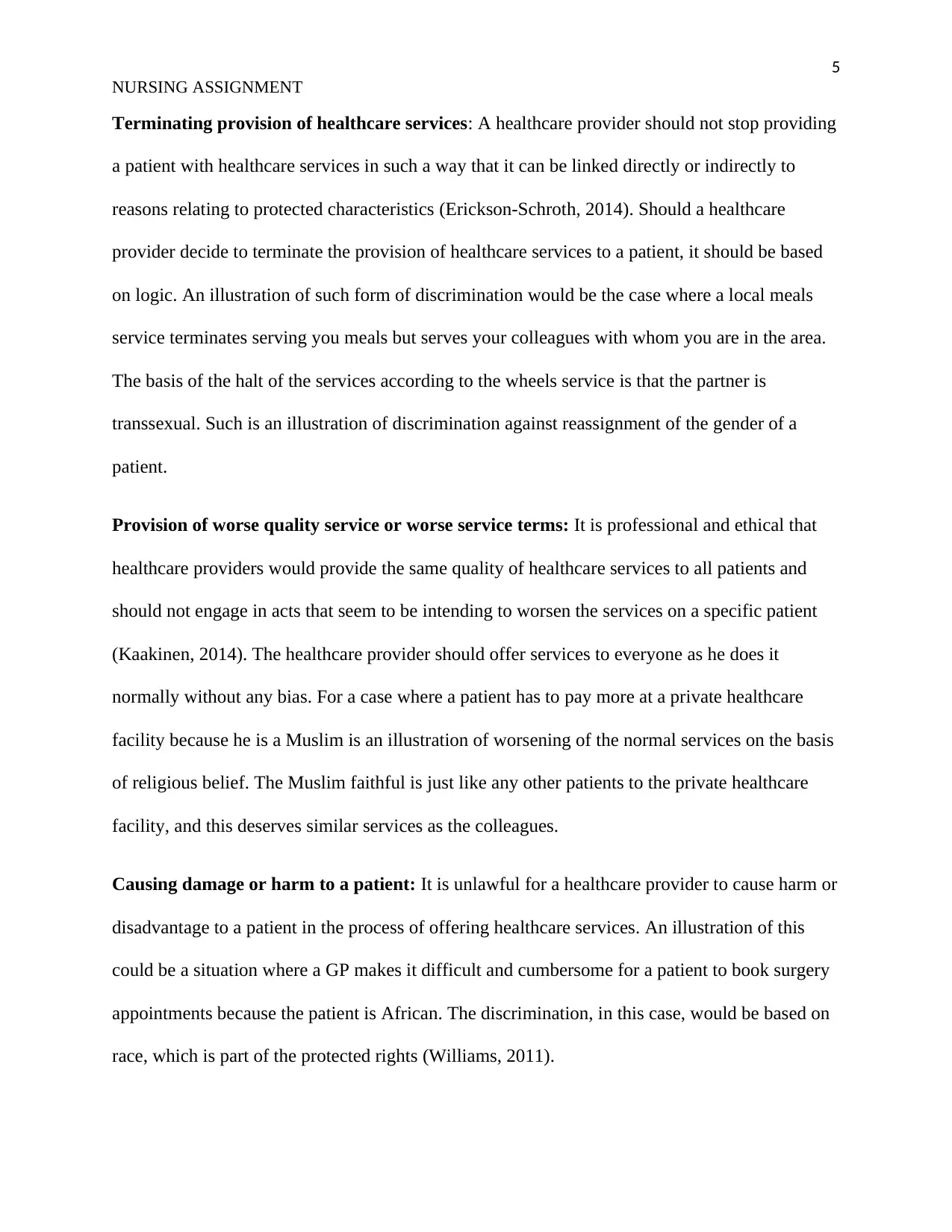
5
NURSING ASSIGNMENT
Terminating provision of healthcare services: A healthcare provider should not stop providing
a patient with healthcare services in such a way that it can be linked directly or indirectly to
reasons relating to protected characteristics (Erickson-Schroth, 2014). Should a healthcare
provider decide to terminate the provision of healthcare services to a patient, it should be based
on logic. An illustration of such form of discrimination would be the case where a local meals
service terminates serving you meals but serves your colleagues with whom you are in the area.
The basis of the halt of the services according to the wheels service is that the partner is
transsexual. Such is an illustration of discrimination against reassignment of the gender of a
patient.
Provision of worse quality service or worse service terms: It is professional and ethical that
healthcare providers would provide the same quality of healthcare services to all patients and
should not engage in acts that seem to be intending to worsen the services on a specific patient
(Kaakinen, 2014). The healthcare provider should offer services to everyone as he does it
normally without any bias. For a case where a patient has to pay more at a private healthcare
facility because he is a Muslim is an illustration of worsening of the normal services on the basis
of religious belief. The Muslim faithful is just like any other patients to the private healthcare
facility, and this deserves similar services as the colleagues.
Causing damage or harm to a patient: It is unlawful for a healthcare provider to cause harm or
disadvantage to a patient in the process of offering healthcare services. An illustration of this
could be a situation where a GP makes it difficult and cumbersome for a patient to book surgery
appointments because the patient is African. The discrimination, in this case, would be based on
race, which is part of the protected rights (Williams, 2011).
NURSING ASSIGNMENT
Terminating provision of healthcare services: A healthcare provider should not stop providing
a patient with healthcare services in such a way that it can be linked directly or indirectly to
reasons relating to protected characteristics (Erickson-Schroth, 2014). Should a healthcare
provider decide to terminate the provision of healthcare services to a patient, it should be based
on logic. An illustration of such form of discrimination would be the case where a local meals
service terminates serving you meals but serves your colleagues with whom you are in the area.
The basis of the halt of the services according to the wheels service is that the partner is
transsexual. Such is an illustration of discrimination against reassignment of the gender of a
patient.
Provision of worse quality service or worse service terms: It is professional and ethical that
healthcare providers would provide the same quality of healthcare services to all patients and
should not engage in acts that seem to be intending to worsen the services on a specific patient
(Kaakinen, 2014). The healthcare provider should offer services to everyone as he does it
normally without any bias. For a case where a patient has to pay more at a private healthcare
facility because he is a Muslim is an illustration of worsening of the normal services on the basis
of religious belief. The Muslim faithful is just like any other patients to the private healthcare
facility, and this deserves similar services as the colleagues.
Causing damage or harm to a patient: It is unlawful for a healthcare provider to cause harm or
disadvantage to a patient in the process of offering healthcare services. An illustration of this
could be a situation where a GP makes it difficult and cumbersome for a patient to book surgery
appointments because the patient is African. The discrimination, in this case, would be based on
race, which is part of the protected rights (Williams, 2011).
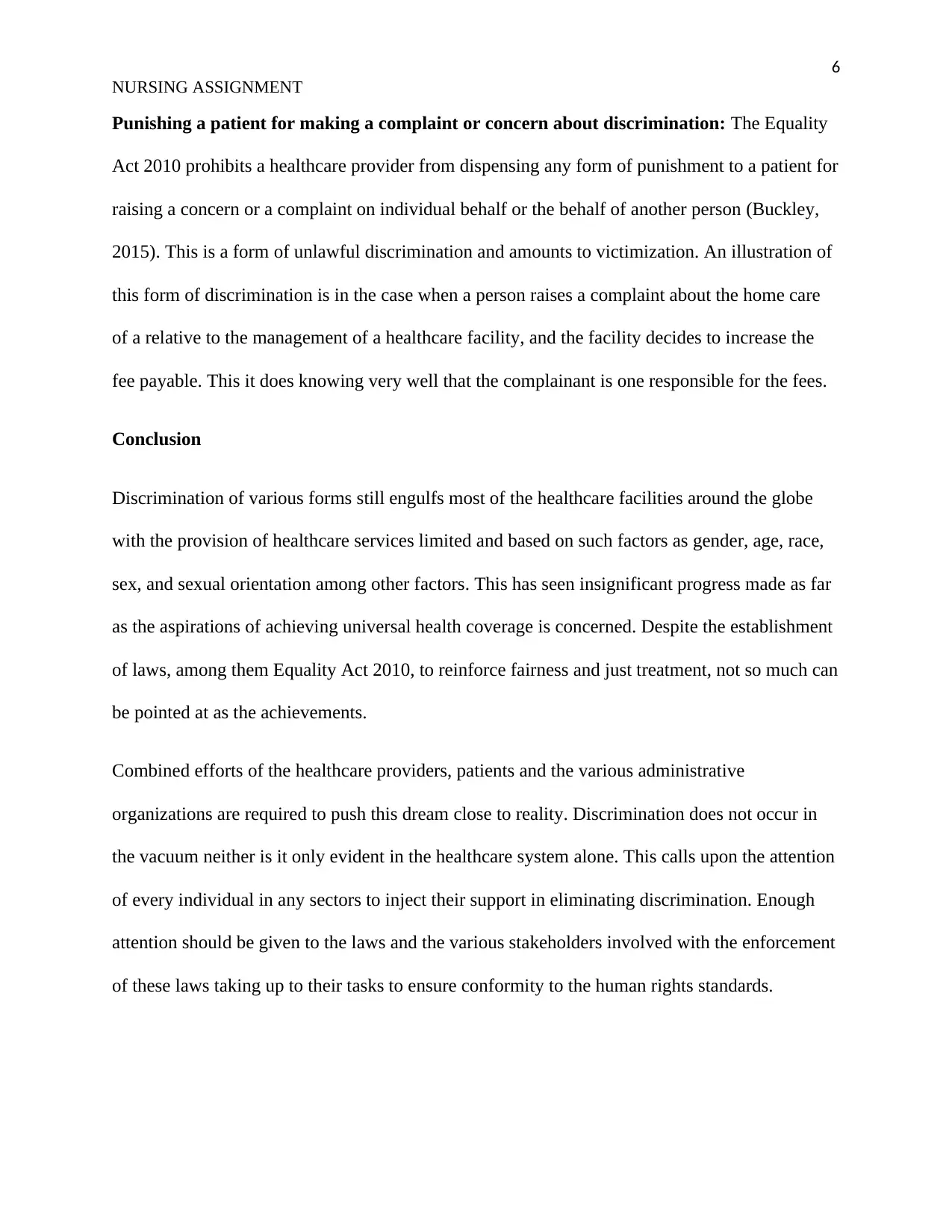
6
NURSING ASSIGNMENT
Punishing a patient for making a complaint or concern about discrimination: The Equality
Act 2010 prohibits a healthcare provider from dispensing any form of punishment to a patient for
raising a concern or a complaint on individual behalf or the behalf of another person (Buckley,
2015). This is a form of unlawful discrimination and amounts to victimization. An illustration of
this form of discrimination is in the case when a person raises a complaint about the home care
of a relative to the management of a healthcare facility, and the facility decides to increase the
fee payable. This it does knowing very well that the complainant is one responsible for the fees.
Conclusion
Discrimination of various forms still engulfs most of the healthcare facilities around the globe
with the provision of healthcare services limited and based on such factors as gender, age, race,
sex, and sexual orientation among other factors. This has seen insignificant progress made as far
as the aspirations of achieving universal health coverage is concerned. Despite the establishment
of laws, among them Equality Act 2010, to reinforce fairness and just treatment, not so much can
be pointed at as the achievements.
Combined efforts of the healthcare providers, patients and the various administrative
organizations are required to push this dream close to reality. Discrimination does not occur in
the vacuum neither is it only evident in the healthcare system alone. This calls upon the attention
of every individual in any sectors to inject their support in eliminating discrimination. Enough
attention should be given to the laws and the various stakeholders involved with the enforcement
of these laws taking up to their tasks to ensure conformity to the human rights standards.
NURSING ASSIGNMENT
Punishing a patient for making a complaint or concern about discrimination: The Equality
Act 2010 prohibits a healthcare provider from dispensing any form of punishment to a patient for
raising a concern or a complaint on individual behalf or the behalf of another person (Buckley,
2015). This is a form of unlawful discrimination and amounts to victimization. An illustration of
this form of discrimination is in the case when a person raises a complaint about the home care
of a relative to the management of a healthcare facility, and the facility decides to increase the
fee payable. This it does knowing very well that the complainant is one responsible for the fees.
Conclusion
Discrimination of various forms still engulfs most of the healthcare facilities around the globe
with the provision of healthcare services limited and based on such factors as gender, age, race,
sex, and sexual orientation among other factors. This has seen insignificant progress made as far
as the aspirations of achieving universal health coverage is concerned. Despite the establishment
of laws, among them Equality Act 2010, to reinforce fairness and just treatment, not so much can
be pointed at as the achievements.
Combined efforts of the healthcare providers, patients and the various administrative
organizations are required to push this dream close to reality. Discrimination does not occur in
the vacuum neither is it only evident in the healthcare system alone. This calls upon the attention
of every individual in any sectors to inject their support in eliminating discrimination. Enough
attention should be given to the laws and the various stakeholders involved with the enforcement
of these laws taking up to their tasks to ensure conformity to the human rights standards.
⊘ This is a preview!⊘
Do you want full access?
Subscribe today to unlock all pages.

Trusted by 1+ million students worldwide
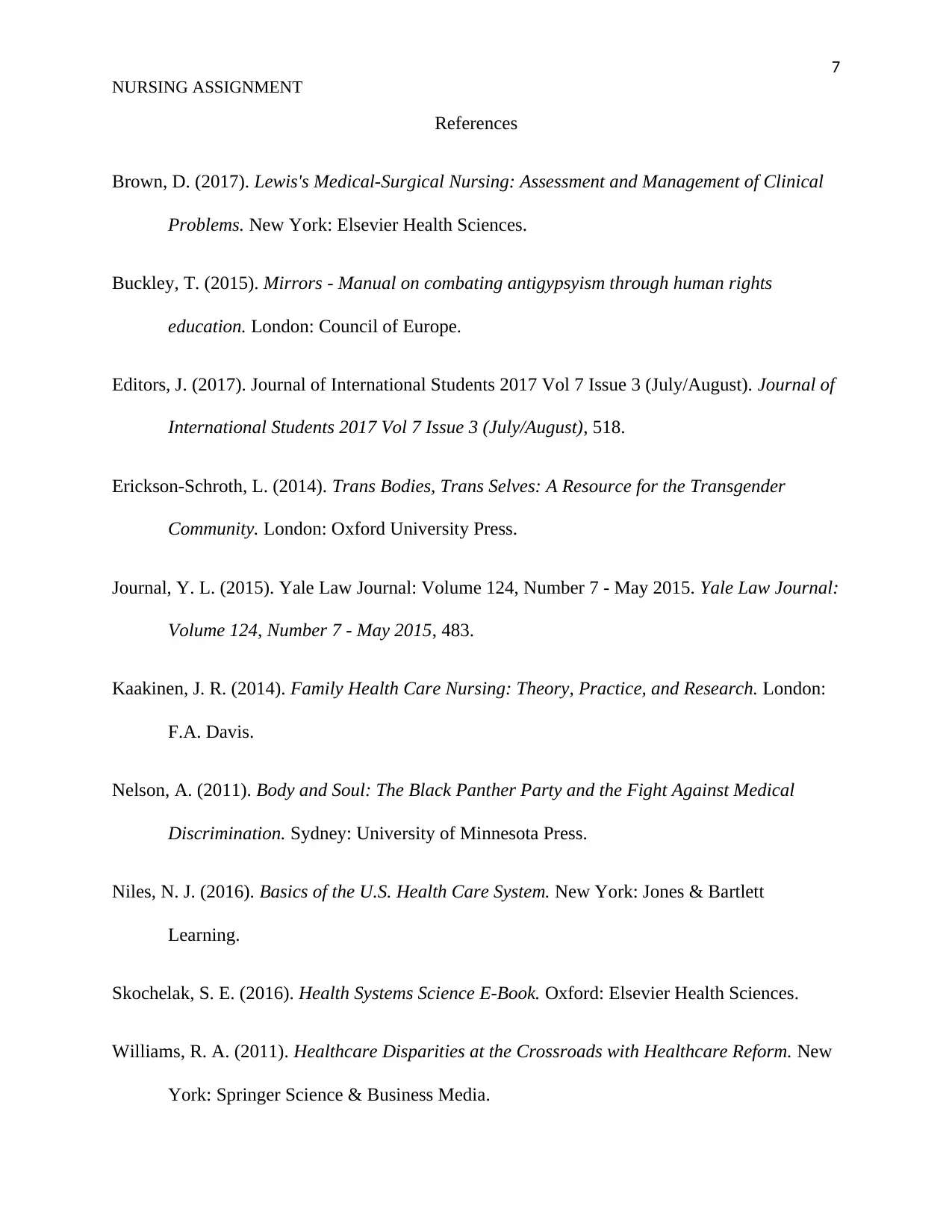
7
NURSING ASSIGNMENT
References
Brown, D. (2017). Lewis's Medical-Surgical Nursing: Assessment and Management of Clinical
Problems. New York: Elsevier Health Sciences.
Buckley, T. (2015). Mirrors - Manual on combating antigypsyism through human rights
education. London: Council of Europe.
Editors, J. (2017). Journal of International Students 2017 Vol 7 Issue 3 (July/August). Journal of
International Students 2017 Vol 7 Issue 3 (July/August), 518.
Erickson-Schroth, L. (2014). Trans Bodies, Trans Selves: A Resource for the Transgender
Community. London: Oxford University Press.
Journal, Y. L. (2015). Yale Law Journal: Volume 124, Number 7 - May 2015. Yale Law Journal:
Volume 124, Number 7 - May 2015, 483.
Kaakinen, J. R. (2014). Family Health Care Nursing: Theory, Practice, and Research. London:
F.A. Davis.
Nelson, A. (2011). Body and Soul: The Black Panther Party and the Fight Against Medical
Discrimination. Sydney: University of Minnesota Press.
Niles, N. J. (2016). Basics of the U.S. Health Care System. New York: Jones & Bartlett
Learning.
Skochelak, S. E. (2016). Health Systems Science E-Book. Oxford: Elsevier Health Sciences.
Williams, R. A. (2011). Healthcare Disparities at the Crossroads with Healthcare Reform. New
York: Springer Science & Business Media.
NURSING ASSIGNMENT
References
Brown, D. (2017). Lewis's Medical-Surgical Nursing: Assessment and Management of Clinical
Problems. New York: Elsevier Health Sciences.
Buckley, T. (2015). Mirrors - Manual on combating antigypsyism through human rights
education. London: Council of Europe.
Editors, J. (2017). Journal of International Students 2017 Vol 7 Issue 3 (July/August). Journal of
International Students 2017 Vol 7 Issue 3 (July/August), 518.
Erickson-Schroth, L. (2014). Trans Bodies, Trans Selves: A Resource for the Transgender
Community. London: Oxford University Press.
Journal, Y. L. (2015). Yale Law Journal: Volume 124, Number 7 - May 2015. Yale Law Journal:
Volume 124, Number 7 - May 2015, 483.
Kaakinen, J. R. (2014). Family Health Care Nursing: Theory, Practice, and Research. London:
F.A. Davis.
Nelson, A. (2011). Body and Soul: The Black Panther Party and the Fight Against Medical
Discrimination. Sydney: University of Minnesota Press.
Niles, N. J. (2016). Basics of the U.S. Health Care System. New York: Jones & Bartlett
Learning.
Skochelak, S. E. (2016). Health Systems Science E-Book. Oxford: Elsevier Health Sciences.
Williams, R. A. (2011). Healthcare Disparities at the Crossroads with Healthcare Reform. New
York: Springer Science & Business Media.
Paraphrase This Document
Need a fresh take? Get an instant paraphrase of this document with our AI Paraphraser

8
NURSING ASSIGNMENT
NURSING ASSIGNMENT
1 out of 8
Related Documents
Your All-in-One AI-Powered Toolkit for Academic Success.
+13062052269
info@desklib.com
Available 24*7 on WhatsApp / Email
![[object Object]](/_next/static/media/star-bottom.7253800d.svg)
Unlock your academic potential
Copyright © 2020–2025 A2Z Services. All Rights Reserved. Developed and managed by ZUCOL.




